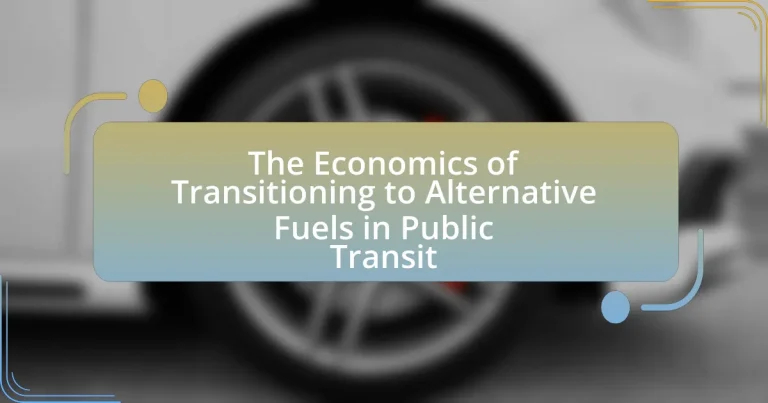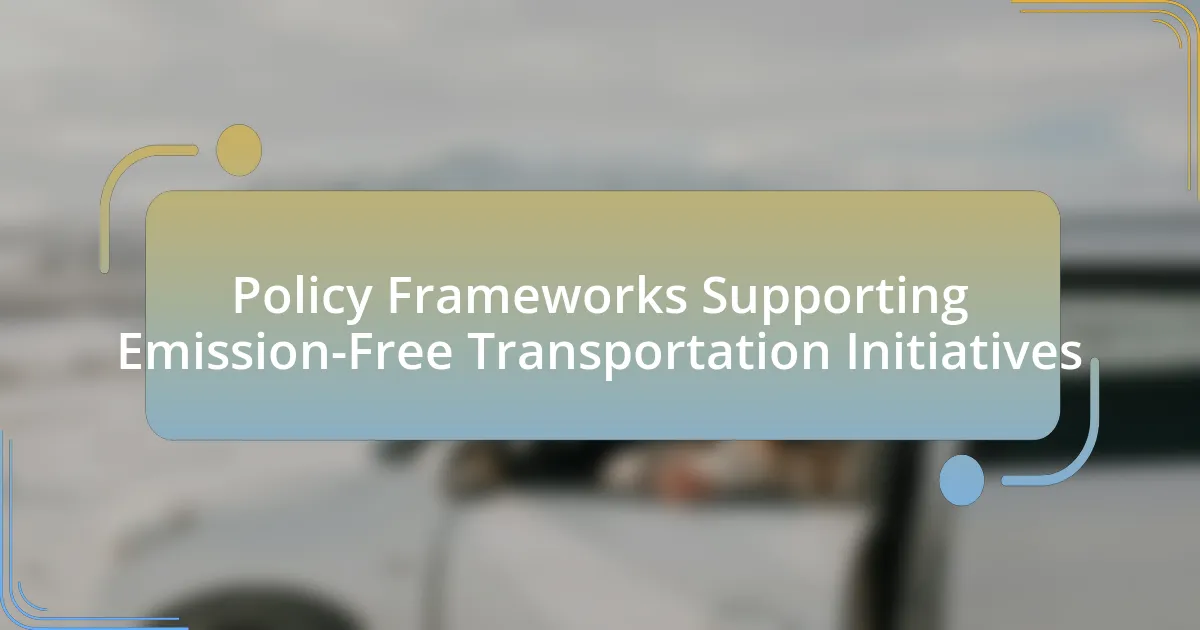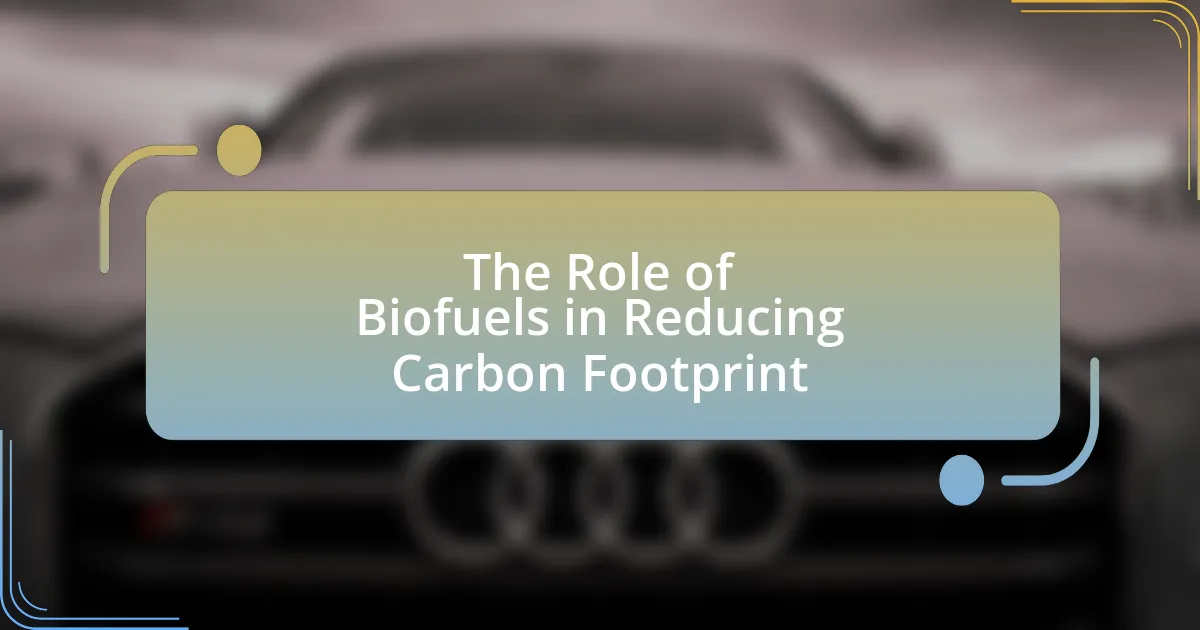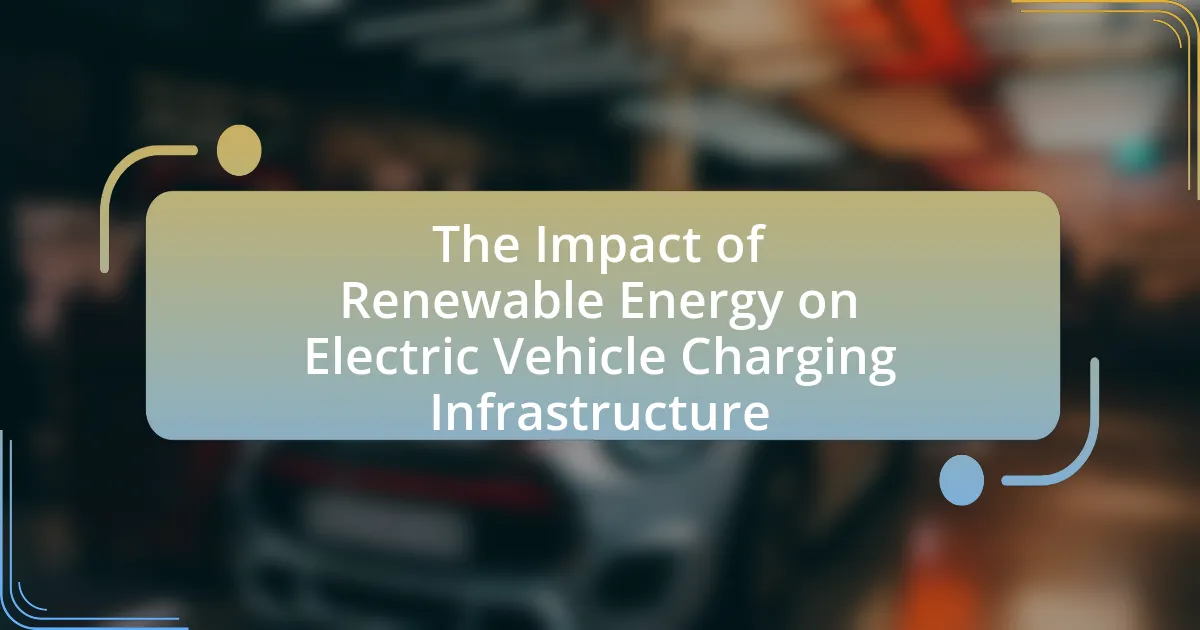The article examines the economic factors influencing the transition to alternative fuels in public transit, focusing on aspects such as fuel costs, government incentives, infrastructure investment, and total cost of ownership. It highlights how rising fuel prices and government policies drive the adoption of cleaner technologies, while also addressing the challenges transit agencies face, including high initial costs and infrastructure limitations. The discussion includes specific alternative fuels like electric, hydrogen, biodiesel, and compressed natural gas, analyzing their economic implications and operational benefits. Additionally, the article outlines best practices for public transit agencies to facilitate a successful transition to alternative fuels, emphasizing the importance of feasibility studies, staff training, and partnerships with fuel suppliers.
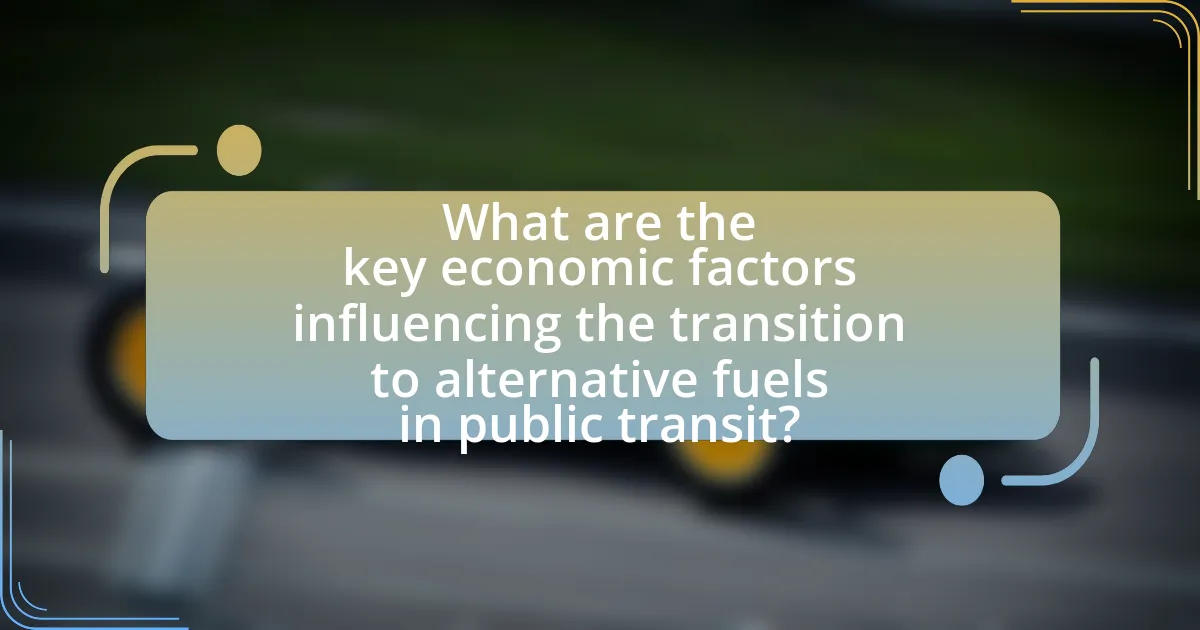
What are the key economic factors influencing the transition to alternative fuels in public transit?
The key economic factors influencing the transition to alternative fuels in public transit include the cost of fuel, government incentives, infrastructure investment, and total cost of ownership. The cost of fuel directly impacts operational expenses; for instance, alternative fuels like electricity or hydrogen can be cheaper than diesel over time. Government incentives, such as tax credits and grants, encourage transit agencies to adopt cleaner technologies, making the transition financially viable. Infrastructure investment is crucial, as the availability of refueling stations and maintenance facilities affects the feasibility of alternative fuel adoption. Lastly, the total cost of ownership, which encompasses purchase price, maintenance, and fuel costs, plays a significant role in decision-making; studies show that electric buses can have lower lifetime costs compared to traditional buses, reinforcing the economic rationale for transitioning to alternative fuels.
How do fuel costs impact public transit budgets?
Fuel costs significantly impact public transit budgets by directly influencing operational expenses. When fuel prices rise, transit agencies face increased costs for fuel procurement, which can consume a substantial portion of their budgets; for instance, in 2022, fuel expenses accounted for approximately 10-15% of total operating costs for many transit systems. This escalation in fuel costs often leads to budget reallocations, forcing agencies to cut back on services, delay maintenance, or increase fares to maintain financial stability. Additionally, fluctuating fuel prices create uncertainty in budget forecasting, complicating long-term financial planning for public transit agencies.
What are the current trends in fuel pricing for alternative fuels?
Current trends in fuel pricing for alternative fuels indicate a gradual increase in costs, driven by rising demand and regulatory support for cleaner energy sources. For instance, the price of biodiesel has seen fluctuations, with recent averages around $4.50 per gallon, reflecting a 20% increase over the past year due to supply chain disruptions and increased feedstock costs. Similarly, electric vehicle charging costs have risen, with average prices reaching $0.15 to $0.25 per kWh, influenced by higher electricity rates and infrastructure investments. These trends are supported by data from the U.S. Energy Information Administration, which highlights a consistent upward trajectory in alternative fuel prices as the market adapts to growing environmental regulations and consumer preferences for sustainable options.
How do fluctuations in oil prices affect the adoption of alternative fuels?
Fluctuations in oil prices significantly influence the adoption of alternative fuels, as higher oil prices typically drive increased interest and investment in alternative energy sources. When oil prices rise, the cost of traditional fossil fuels becomes less competitive, prompting consumers and businesses to seek more cost-effective and sustainable options, such as biofuels, electricity, and hydrogen. For instance, a study by the International Energy Agency found that a 10% increase in oil prices can lead to a 5% increase in the adoption of alternative fuels, as stakeholders look to mitigate fuel costs and enhance energy security. Conversely, when oil prices drop, the urgency to transition to alternative fuels diminishes, as conventional fuels become more economically attractive, leading to slower adoption rates.
What role do government policies play in the economics of alternative fuels?
Government policies significantly influence the economics of alternative fuels by providing financial incentives, regulatory frameworks, and research funding. These policies can lower the cost of production and distribution of alternative fuels, making them more competitive with traditional fossil fuels. For instance, tax credits and subsidies for biofuels and electric vehicles have been implemented in various countries, resulting in increased adoption rates and investment in infrastructure. According to the U.S. Department of Energy, federal tax incentives have led to a substantial rise in the production of renewable fuels, demonstrating the effectiveness of such policies in shaping market dynamics.
What incentives are available for public transit agencies to adopt alternative fuels?
Public transit agencies can access various incentives to adopt alternative fuels, including federal grants, tax credits, and state-level funding programs. For instance, the Federal Transit Administration offers the Low or No Emission Vehicle Program, which provides funding specifically for the purchase of low or no-emission buses and related equipment. Additionally, the Alternative Fuel Tax Credit allows agencies to receive a tax credit for the use of alternative fuels, which can significantly reduce operational costs. State governments often have their own programs, such as California’s Hybrid and Zero-Emission Truck and Bus Voucher Incentive Project, which further supports the transition to cleaner fuels. These incentives are designed to lower the financial barriers associated with transitioning to alternative fuels, promoting environmental sustainability and reducing greenhouse gas emissions in public transit systems.
How do regulations shape the economic feasibility of alternative fuel adoption?
Regulations significantly influence the economic feasibility of alternative fuel adoption by establishing standards and incentives that affect costs and market dynamics. For instance, government mandates for emissions reductions compel transit agencies to invest in cleaner technologies, often leading to increased initial capital expenditures. However, regulations can also provide financial incentives, such as tax credits or grants, which can offset these costs and enhance the attractiveness of alternative fuels. According to the U.S. Department of Energy, the implementation of the Renewable Fuel Standard has led to a substantial increase in the production and use of biofuels, demonstrating how regulatory frameworks can drive market growth and innovation in alternative fuel sectors.
What are the long-term economic benefits of transitioning to alternative fuels?
Transitioning to alternative fuels offers significant long-term economic benefits, including reduced operational costs, enhanced energy security, and job creation in emerging industries. By utilizing alternative fuels, public transit systems can lower fuel expenses, as many alternative sources, such as electricity and biofuels, can be more cost-effective than traditional fossil fuels over time. Additionally, this transition decreases dependence on imported oil, thereby stabilizing energy prices and fostering local energy production. According to a report by the U.S. Department of Energy, investments in alternative fuel technologies could create over 1.5 million jobs by 2030, stimulating economic growth and innovation in the energy sector.
How can alternative fuels reduce operational costs in public transit?
Alternative fuels can reduce operational costs in public transit by lowering fuel expenses and maintenance costs. For instance, compressed natural gas (CNG) is often cheaper than diesel, resulting in significant savings on fuel expenditures. Additionally, alternative fuel vehicles typically require less maintenance due to fewer moving parts and reduced wear and tear, which can further decrease operational costs. According to the American Public Transportation Association, transit agencies that have adopted alternative fuels have reported savings of up to 30% in fuel costs and a reduction in maintenance expenses by as much as 20%.
What are the potential savings in maintenance and infrastructure with alternative fuels?
Alternative fuels can lead to significant savings in maintenance and infrastructure costs, primarily due to reduced wear and tear on vehicles and lower emissions. For instance, electric buses, which utilize alternative fuels, have fewer moving parts compared to traditional diesel buses, resulting in lower maintenance costs. A study by the American Public Transportation Association found that electric buses can save up to 60% in maintenance costs over their lifetime compared to diesel buses. Additionally, alternative fuels often contribute to less corrosive emissions, which can extend the lifespan of infrastructure such as roads and bridges. This reduction in infrastructure degradation can lead to substantial savings in repair and replacement costs over time.
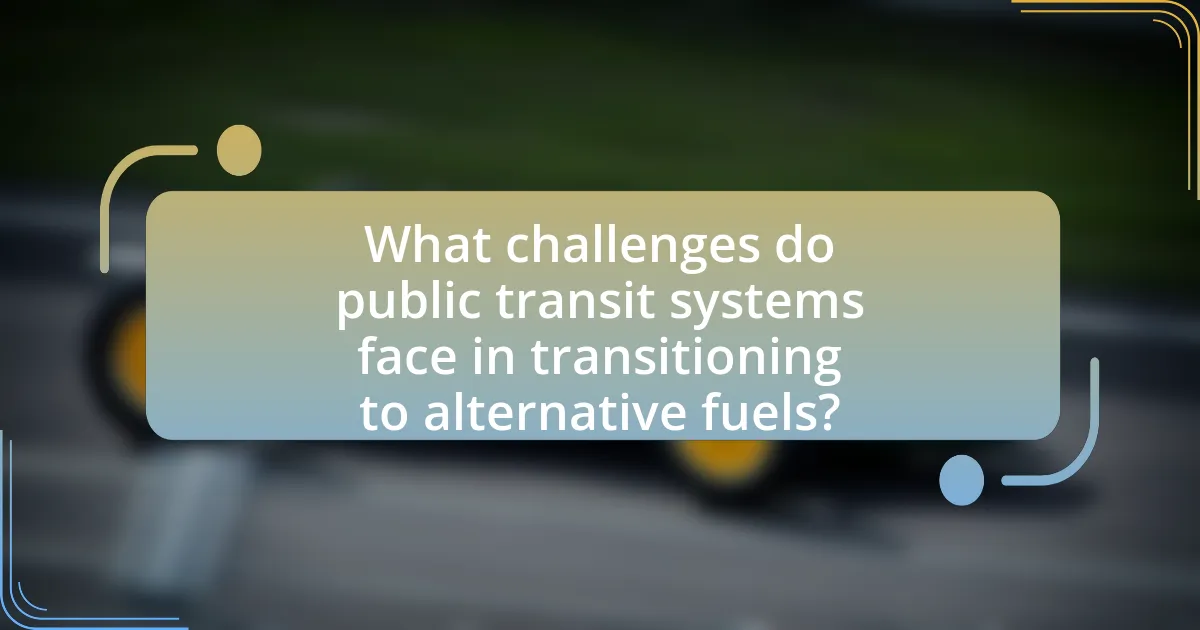
What challenges do public transit systems face in transitioning to alternative fuels?
Public transit systems face significant challenges in transitioning to alternative fuels, primarily due to high initial costs, infrastructure limitations, and regulatory hurdles. The transition often requires substantial investment in new vehicles and fueling stations, which can strain budgets; for instance, electric buses can cost up to three times more than traditional diesel buses. Additionally, existing infrastructure may not support alternative fuel technologies, necessitating upgrades or replacements that further increase costs. Regulatory challenges also arise, as public transit agencies must navigate complex policies and standards that vary by region, complicating the implementation of alternative fuel solutions. These factors collectively hinder the swift adoption of alternative fuels in public transit systems.
What are the initial costs associated with switching to alternative fuels?
The initial costs associated with switching to alternative fuels include the expenses for new vehicles, infrastructure modifications, and fuel supply systems. For instance, purchasing alternative fuel vehicles can be significantly higher than conventional vehicles; for example, electric buses can cost between $700,000 to $900,000 each, compared to $300,000 for a diesel bus. Additionally, retrofitting existing facilities to accommodate alternative fuel sources, such as installing charging stations or fueling infrastructure, can range from tens of thousands to millions of dollars depending on the scale of the operation. Furthermore, training personnel to operate and maintain new technologies adds to the initial financial burden. These costs can be substantial, but they are often offset by long-term savings in fuel and maintenance.
How do the costs of new technology and infrastructure impact the transition?
The costs of new technology and infrastructure significantly impact the transition to alternative fuels in public transit by influencing investment decisions and operational feasibility. High initial costs can deter public transit agencies from adopting innovative technologies, as they often operate under tight budgets and require justification for expenditures. For instance, the deployment of electric buses involves substantial upfront investments in vehicles and charging infrastructure, which can exceed millions of dollars per fleet. According to a report by the American Public Transportation Association, transitioning to electric buses can cost between $700,000 to $900,000 per bus, compared to around $500,000 for traditional diesel buses. This financial burden can slow the pace of transition, as agencies may prioritize immediate operational needs over long-term sustainability goals. Additionally, the costs associated with retrofitting existing infrastructure to accommodate new technologies further complicate the transition, as agencies must balance these expenses with their overall budget constraints.
What financing options are available to mitigate these initial costs?
Financing options available to mitigate initial costs in transitioning to alternative fuels in public transit include government grants, low-interest loans, and public-private partnerships. Government grants, such as those from the Federal Transit Administration, provide funding specifically for clean fuel projects, helping to offset upfront expenses. Low-interest loans, often available through state or federal programs, allow transit agencies to finance the purchase of alternative fuel vehicles at reduced costs. Public-private partnerships enable collaboration between government entities and private companies, facilitating investment in infrastructure and technology while sharing financial risks. These financing mechanisms are crucial for making the transition economically viable and sustainable.
How does public perception affect the transition to alternative fuels?
Public perception significantly influences the transition to alternative fuels by shaping consumer demand and policy support. When the public views alternative fuels positively, it encourages investment and development in these technologies, as seen in the growing acceptance of electric vehicles, which has led to increased infrastructure and production. Conversely, negative perceptions, such as concerns over the reliability or environmental impact of alternative fuels, can hinder adoption and slow down necessary policy changes. For instance, a 2021 survey by the International Energy Agency found that public support for electric vehicles was linked to perceptions of their environmental benefits, directly impacting market growth and government incentives.
What are the common misconceptions about alternative fuels in public transit?
Common misconceptions about alternative fuels in public transit include the belief that they are significantly more expensive than traditional fuels, that they lack the infrastructure for widespread use, and that they are less efficient or reliable. In reality, while initial costs for alternative fuel vehicles may be higher, long-term savings from reduced fuel costs and maintenance can offset these expenses. Additionally, infrastructure for alternative fuels, such as electric charging stations and natural gas refueling sites, has been expanding rapidly, with many cities investing in these developments. Furthermore, studies have shown that alternative fuels can be just as efficient and reliable as conventional fuels, with some options, like electric buses, demonstrating lower operational costs and emissions.
How can public transit agencies effectively communicate the benefits of alternative fuels?
Public transit agencies can effectively communicate the benefits of alternative fuels by utilizing targeted outreach strategies that emphasize environmental, economic, and health advantages. For instance, agencies can highlight that alternative fuels, such as electric or hydrogen, reduce greenhouse gas emissions by up to 70% compared to traditional diesel, thereby contributing to cleaner air and combating climate change. Additionally, they can present data showing that transitioning to alternative fuels can lower operational costs by reducing fuel expenses and maintenance needs, as electric buses have fewer moving parts than their diesel counterparts. Engaging the community through workshops, social media campaigns, and partnerships with local organizations can further enhance awareness and acceptance of these benefits, ultimately fostering public support for the transition to alternative fuels in public transit systems.
What logistical challenges must be addressed during the transition?
Logistical challenges during the transition to alternative fuels in public transit include infrastructure development, supply chain management, and workforce training. Infrastructure development is critical as existing facilities may not support new fueling systems, requiring significant investment in new stations and maintenance facilities. Supply chain management must ensure a reliable and consistent supply of alternative fuels, which can be disrupted by market fluctuations or limited availability. Workforce training is essential to equip employees with the necessary skills to operate and maintain new technologies, as a lack of trained personnel can hinder the transition process. These challenges must be systematically addressed to facilitate a smooth transition to alternative fuels in public transit systems.
How can transit agencies manage the integration of alternative fuel vehicles into existing fleets?
Transit agencies can manage the integration of alternative fuel vehicles into existing fleets by conducting thorough assessments of current fleet operations, identifying suitable alternative fuel technologies, and developing a phased implementation plan. This approach allows agencies to evaluate the operational impacts, costs, and benefits of alternative fuels, such as electric or hydrogen, while ensuring compatibility with existing infrastructure. For instance, a study by the American Public Transportation Association indicates that transitioning to alternative fuels can reduce greenhouse gas emissions by up to 45%, demonstrating the environmental and economic advantages of such integration. Additionally, agencies should invest in training for staff and maintenance personnel to ensure effective operation and upkeep of new vehicles, further supporting a smooth transition.
What training is necessary for staff to operate alternative fuel technologies?
Staff operating alternative fuel technologies require specialized training in safety protocols, system operation, and maintenance procedures specific to alternative fuels such as electric, hydrogen, and biofuels. This training typically includes understanding the unique properties of these fuels, the technology used in vehicles, and emergency response measures. For instance, the National Renewable Energy Laboratory emphasizes the importance of training programs that cover the operational differences between traditional and alternative fuel vehicles, ensuring staff can effectively manage and troubleshoot these systems. Additionally, certifications in handling hazardous materials may be necessary, particularly for hydrogen and biofuels, to comply with safety regulations and industry standards.

What specific alternative fuels are being considered for public transit, and what are their economic implications?
Public transit is considering several specific alternative fuels, including electric, hydrogen, biodiesel, and compressed natural gas (CNG). The economic implications of these fuels vary: electric buses can reduce long-term operational costs due to lower fuel and maintenance expenses, while hydrogen fuel cells offer quick refueling and longer ranges but require significant infrastructure investment. Biodiesel, derived from renewable sources, can be economically viable with existing diesel engines but may face feedstock price volatility. CNG is often cheaper than diesel, providing immediate cost savings, yet its adoption is limited by the need for specialized fueling stations. Overall, transitioning to these alternative fuels can lead to reduced greenhouse gas emissions and long-term savings, but initial investment and infrastructure development remain critical economic considerations.
What are the advantages and disadvantages of electric buses in public transit?
Electric buses in public transit offer several advantages and disadvantages. The primary advantage is their environmental benefit; electric buses produce zero tailpipe emissions, significantly reducing air pollution in urban areas. According to the American Public Transportation Association, electric buses can reduce greenhouse gas emissions by up to 70% compared to diesel buses, contributing to cleaner air and improved public health.
On the downside, electric buses have higher upfront costs, with prices ranging from $700,000 to $900,000 per bus, compared to $300,000 to $500,000 for diesel buses. Additionally, the limited range of electric buses, typically around 150 to 300 miles on a single charge, can pose challenges for transit systems that require longer routes without frequent charging stations. Furthermore, the charging infrastructure needed to support electric buses can be costly and complex to implement, potentially leading to increased operational expenses.
How do the costs of electric buses compare to traditional diesel buses?
Electric buses generally have higher upfront costs compared to traditional diesel buses, with prices ranging from $700,000 to $900,000 for electric buses versus $300,000 to $500,000 for diesel buses. However, electric buses offer significantly lower operational costs, including reduced fuel expenses and lower maintenance costs, which can lead to savings of approximately $0.15 to $0.30 per mile compared to diesel buses. Over their lifespan, the total cost of ownership for electric buses can become competitive with diesel buses, especially when considering incentives and the decreasing costs of battery technology.
What infrastructure investments are needed for electric bus deployment?
Electric bus deployment requires significant investments in charging infrastructure, maintenance facilities, and grid upgrades. Charging infrastructure must include fast-charging stations strategically located along bus routes and at depots to ensure operational efficiency. Maintenance facilities need to be equipped with specialized tools and training for electric bus technology, which differs from traditional diesel buses. Additionally, grid upgrades are essential to handle the increased electricity demand from charging multiple buses simultaneously, ensuring reliability and sustainability of the power supply. According to the American Public Transportation Association, transitioning to electric buses can reduce greenhouse gas emissions by up to 80%, highlighting the importance of these infrastructure investments for effective deployment.
How do hydrogen fuel cell vehicles fit into the public transit landscape?
Hydrogen fuel cell vehicles (FCVs) are increasingly integrated into the public transit landscape as a sustainable alternative to traditional fossil fuel-powered buses. These vehicles produce zero tailpipe emissions, contributing to improved air quality and reduced greenhouse gas emissions in urban areas. For instance, the California Fuel Cell Partnership reported that hydrogen buses can operate with a range of approximately 300 miles and refuel in about 15 minutes, making them suitable for the demands of public transit systems. Additionally, several transit agencies, such as the Alameda-Contra Costa Transit District, have successfully deployed hydrogen fuel cell buses, demonstrating their viability in real-world operations. This transition aligns with broader goals of reducing reliance on fossil fuels and enhancing the sustainability of public transportation.
What are the economic considerations of hydrogen production and distribution?
The economic considerations of hydrogen production and distribution include production costs, infrastructure investment, and market demand. Production costs for hydrogen vary significantly based on the method used, with electrolysis being more expensive than steam methane reforming, which currently dominates the market. Infrastructure investment is substantial, as it requires new pipelines, storage facilities, and refueling stations, with estimates suggesting that building a hydrogen infrastructure could cost billions of dollars. Market demand is influenced by government policies promoting clean energy and the competitiveness of hydrogen against other fuels; for instance, the global hydrogen market is projected to reach $200 billion by 2025, driven by increasing interest in decarbonization. These factors collectively shape the economic viability of hydrogen as a fuel source in public transit.
How does the performance of hydrogen fuel cells compare to other alternatives?
Hydrogen fuel cells generally offer higher energy efficiency and faster refueling times compared to battery electric vehicles (BEVs) and internal combustion engines (ICEs). Specifically, hydrogen fuel cells can achieve efficiencies of around 60% in converting hydrogen to electricity, while BEVs typically operate at about 20-25% efficiency when considering the entire energy cycle from generation to wheel. Additionally, hydrogen fuel cells can be refueled in approximately 5 minutes, significantly quicker than the charging times for BEVs, which can take from 30 minutes to several hours depending on the charging infrastructure. This performance advantage makes hydrogen fuel cells particularly suitable for heavy-duty applications in public transit, where quick turnaround times are essential.
What role does biofuel play in the transition to alternative fuels in public transit?
Biofuel serves as a crucial intermediary in the transition to alternative fuels in public transit by providing a renewable energy source that can reduce greenhouse gas emissions and dependence on fossil fuels. Specifically, biofuels, such as biodiesel and ethanol, can be integrated into existing transit systems with minimal modifications, allowing for a smoother transition compared to entirely new technologies. For instance, according to the U.S. Department of Energy, using biodiesel blends can reduce emissions of particulate matter by up to 47% compared to conventional diesel. This demonstrates biofuel’s effectiveness in improving air quality while supporting the broader shift towards sustainable energy solutions in public transportation.
What are the economic benefits of using biofuels in existing diesel engines?
The economic benefits of using biofuels in existing diesel engines include reduced fuel costs, lower greenhouse gas emissions, and potential government incentives. Biofuels can often be produced at a lower cost than traditional fossil fuels, leading to savings for operators. For instance, a study by the U.S. Department of Energy found that biodiesel can be produced for as low as $2.50 per gallon, compared to $3.00 for conventional diesel. Additionally, biofuels contribute to a decrease in greenhouse gas emissions, which can result in lower compliance costs with environmental regulations. Furthermore, many governments offer tax credits and subsidies for biofuel use, enhancing the financial viability for public transit systems.
How does the availability of biofuels impact their adoption in public transit?
The availability of biofuels significantly enhances their adoption in public transit by providing a viable alternative to traditional fossil fuels. When biofuels are readily accessible, transit agencies can implement them more easily, leading to reduced greenhouse gas emissions and lower operational costs. For instance, a study by the National Renewable Energy Laboratory found that using biodiesel in public transit can reduce lifecycle greenhouse gas emissions by up to 78% compared to petroleum diesel. This availability not only supports environmental goals but also aligns with public policies promoting sustainable transportation, thereby increasing the likelihood of adoption among transit authorities.
What best practices can public transit agencies adopt for a successful transition to alternative fuels?
Public transit agencies can adopt several best practices for a successful transition to alternative fuels, including conducting comprehensive feasibility studies, investing in staff training, and establishing partnerships with fuel suppliers. Comprehensive feasibility studies allow agencies to assess the economic viability and environmental impact of alternative fuels, ensuring informed decision-making. Investing in staff training equips personnel with the necessary skills to operate and maintain new fuel technologies, which is crucial for operational efficiency. Establishing partnerships with fuel suppliers can facilitate access to reliable alternative fuel sources and infrastructure, enhancing the transition process. These practices are supported by successful case studies, such as the implementation of compressed natural gas (CNG) buses in various U.S. cities, which have demonstrated reduced emissions and operational costs.
